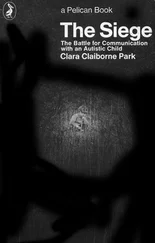Clara Park - Exiting Nirvana
Здесь есть возможность читать онлайн «Clara Park - Exiting Nirvana» весь текст электронной книги совершенно бесплатно (целиком полную версию без сокращений). В некоторых случаях можно слушать аудио, скачать через торрент в формате fb2 и присутствует краткое содержание. ISBN: , Жанр: Психология, на английском языке. Описание произведения, (предисловие) а так же отзывы посетителей доступны на портале библиотеки ЛибКат.
- Название:Exiting Nirvana
- Автор:
- Жанр:
- Год:неизвестен
- ISBN:0-316-69117-8
- Рейтинг книги:4 / 5. Голосов: 1
-
Избранное:Добавить в избранное
- Отзывы:
-
Ваша оценка:
- 80
- 1
- 2
- 3
- 4
- 5
Exiting Nirvana: краткое содержание, описание и аннотация
Предлагаем к чтению аннотацию, описание, краткое содержание или предисловие (зависит от того, что написал сам автор книги «Exiting Nirvana»). Если вы не нашли необходимую информацию о книге — напишите в комментариях, мы постараемся отыскать её.
All illustrations are by Jessy Park.
Exiting Nirvana — читать онлайн бесплатно полную книгу (весь текст) целиком
Ниже представлен текст книги, разбитый по страницам. Система сохранения места последней прочитанной страницы, позволяет с удобством читать онлайн бесплатно книгу «Exiting Nirvana», без необходимости каждый раз заново искать на чём Вы остановились. Поставьте закладку, и сможете в любой момент перейти на страницу, на которой закончили чтение.
Интервал:
Закладка:
The suitcase records the critical years of Jessy’s growth — roughly from age nine to sixteen. Revisiting it, exploring it not a sheet at a time but in its full accumulation, I am overwhelmed by more than volume. To write the past is to discover it. I am overwhelmed by the expenditure of mental energy it represents, by the sheer activity of a mind that in its inaccessibility could seem so empty. At three, wordless, Jessy had lined up objects in rows and we had thought that must, must be a sign of intelligence. Now we could see intelligence’s paper trail. The pages that follow are an attempt to unpack the contents of that suitcase.
Imagine finding this on a piece of paper:
NO
KNOW
YES
KYESW
It’s logical, isn’t it? It figures. It is no weak or torpid mind that spontaneously processes KNOW into KYESW. It is a mind that has searched for a rule and found it. Language doesn’t work by logic, but Jessy at eleven wasn’t interested in language. She was passionately interested in logic, in principles that could introduce order into a world still largely incomprehensible. The purest logic, the surest, is the logic of number; Jessy’s numbers came from the same period. They have their own box, almost as big as the suitcase; I'll unpack it — some of it — in the next chapter.
The suitcase drawings too displayed numbers — everything was connected in that busy mind. But the pictures and letters moved beyond the abstract numbers and shapes that had formed her early kingdom, into a world rooted, however strangely, in her daily life, a world recognizably human.
Even KNOW and KYESW impinged on meaning; Jessy, perforce, had long understood NO, and (though it took more teaching) YES. She was using letters more and more. Even three years earlier she had written MAMA, and formed — logically — the plural MEME on the model of MAN and MEN. I was delighted with KNOW and KYESW, as I was delighted with every sign of intelligence, but I didn’t think much about it at the time. Later I recognized it for what it was: a written record, one of the first, of the systematic quality of Jessy’s mind.
To systematize is to discover regularities and organize them. Like MAMA/MEME, this system was still very simple. Jessy’s interests then were focused on numbers, systematizable in so many more ways. A few years later, however, numbers were receding in favor of words. She was fifteen. She talked more, and more clearly. She was beginning to read and write. And what more significant to write than her own name? JESSIE, JESSY, JESS, JES, JESSE, JESSICA.
Here is what Jessy told me on October 21, 1973. It is no coincidence, I think, that it’s from the same year, even the same month, as the bacon dialogue; that was the year she began to respond to questions with more than yes and no. (It would be many years more before she could offer an explanation on her own.) Since the questions are obvious, I record only her answers:
JESSIE. Because of sunny. And sometimes I say — ICA with a sunny.
And cloudy is JESSY.
And JESS is bad.
And very bad with only one S — JES.
And — E is between good and bad — JESSE.
And with — ICA is a good day. If I in special day sposed to write this one — JESSICA.
What makes a day bad? I asked. «All because of cry and mumble and bump is a very bad».
Yes, it figures. It figures even better than I realized. Only now, as I write, do I discover the system within the system, how the number of letters decreases, a letter at a time, from six to three, from sunny goodness to very bad, then increases to the full affirmation of the seven-letter special day.
It all connects. It does more than connect, it correlates. (Jessy learned that difficult word instantly; as with «heptagon», she already had the concept.) Bacon, egg, toast, badness, goodness, sound, silence. The brilliance of the sun. More precisely, the number of its rays, twenty-four for a really good day, sixteen for good, twelve for average, grading down to one, even, alas, to zero. Jessy generated systems as naturally as she breathed. They proliferated spontaneously, without outside reinforcement; the bacon system had been going on for months before we noticed it. More than anything that happened at school, systems were what exercised her intellectual and emotional energy. Although her engagements with the world were so limited — because they were so limited — she could bestow on her systems a single mindedness unavailable to a normally diversified experience.
A mother is not the most graceful witness to her child’s intelligence. Fortunately there are others. Jessy was twenty-three, the bacon system long past, when two psychologists, Lola Bogyo and Ronald Ellis, became fascinated by the range of what Jessy could (and could not) do. They studied her for months. They gave her every kind of test. It isn’t easy to test an autistic person with limited speech and comprehension, particularly when she is intolerant of errors. With extraordinary sensitivity and imagination, Lola and Ron found ways to make the testing process fun, so that Jessy loved her weekly sessions. Here is how they describe her «fascination for the creation and elaboration of systems».
It became clear that at the root of these systems lay a remarkable ability to induce the rules and regularities that characterized any set of items — numbers, words, objects, or events, [Jessy] not only induced these rules, she system-atically and obsessively explored all of their possible applications. From numbers, colors, and common objects she created complex, intricately ordered systems, some of which she used, it seemed, to structure her world, and some of which she merely played with, endlessly delighted by their order. [18] Lola Bogyo and Ronald Ellis, „Elly: A Study in Contrasts“, in The Exceptional Brain, L. K. Obler and D. Fein, eds. (New York: Guilford Press, 1988), pp. 268–271. The authors have kept the pseudonym I used for Jessy in The Siege.
To explore the limits of Jessy’s «inferential skills», the investigators tried a test expressly designed «to measure an individual’s aptitude for abstraction and rule induction». They chose the Raven’s Progressive Matrices, a nonverbal test suited to her «agrammatical» speech and a comprehension «impaired for complex messages». I cannot better their description:
This test. contains a series of problems graded in difficulty. Each problem consists of a pattern or matrix from which a piece is missing; the subject is given a set of alternatives and must choose the piece that completes the whole. Simple problems consist of a homogeneous pattern (e.g., a grid of dots) from which a piece has been «cut out». More difficult problems present patterns consisting of disparate elements related by subtle and complex rules; simultaneous variations on several different dimensions (e.g., shape, size, orientation) must be attended to in order to induce the underlying regularities. [19] Ibid.
Normal subjects start fast and slow way down; Jessy «quickly began to turn the pages, pausing only to glance briefly at the patterns and point immediately at the missing piece. We waited for her to slow down and falter. We waited in vain». She scored «well above the 95th percentile for ‘normal’ adult subjects». Her friends shifted to the Advanced Progressive Matrices. «Again we watched with amazement as [Jessy] turned the pages more quickly than we could consider the choices. Once again she scored above the 95th percentile, this time being compared to graduate technical and medical students».
Given [Jessy’s] limited language skills, we wondered whether she actually knew and could articulate governing patterns or whether she had somehow been able to guess which pieces would make the wholes «look right».. Despite her stilted broken sentences, she was unfailingly able to name the relevant dimensions and features, to articulate the rules governing their progressive alterations, and to describe how an extrapolation of those rules generated the correct pattern. It was clear that to [Jessy] these rules and regularities were obvious, self-evident in the designs themselves. She seemed puzzled that the solutions needed any explanations at all — as if we had asked her what shaped peg would fit best in a round hole. [20] Ibid.
Интервал:
Закладка:
Похожие книги на «Exiting Nirvana»
Представляем Вашему вниманию похожие книги на «Exiting Nirvana» списком для выбора. Мы отобрали схожую по названию и смыслу литературу в надежде предоставить читателям больше вариантов отыскать новые, интересные, ещё непрочитанные произведения.
Обсуждение, отзывы о книге «Exiting Nirvana» и просто собственные мнения читателей. Оставьте ваши комментарии, напишите, что Вы думаете о произведении, его смысле или главных героях. Укажите что конкретно понравилось, а что нет, и почему Вы так считаете.



![Майкл Азеррад - Come as you are - история Nirvana, рассказанная Куртом Кобейном и записанная Майклом Азеррадом [litres]](/books/392533/majkl-azerrad-come-as-you-are-istoriya-nirvana-ra-thumb.webp)



![Эверетт Тру - Nirvana - Правдивая история [litres]](/books/399241/everett-tru-nirvana-pravdivaya-istoriya-litres-thumb.webp)




